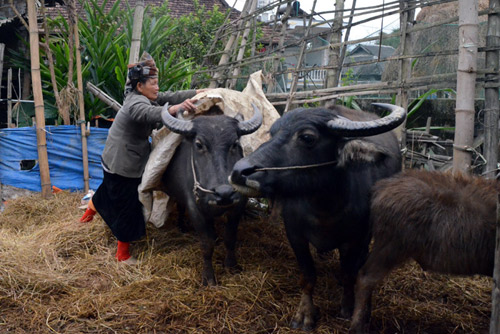 Society
Society

In spite of being implemented in 2011, the Government-supported agriculture insurance programme which aims to protect farmers against losses of crops and livestock has so far failed to attract farmers due to high fees and complicated procedures.

|
| A farmer covers buffaloes with canvas in the winter. The agriculture insurance programme which aims to protect farmers against losses of crops and livestock has failed to attract farmers due to high premium and complicated procedures. — Photo danviet.vn |
HÀ NỘI — In spite of being implemented in 2011, the Government-supported agriculture insurance programme which aims to protect farmers against losses of crops and livestock has so far failed to attract farmers due to high premium and complicated procedures.
The household of Trần Huy Cường, a farmer in Lập Thạch District, northern province of Vĩnh Phúc, was among 6,000 local households to buy agriculture insurance while it was being trialled in 2011-13.
After a year, he decided to end the participation because the insurance premium was high and the compensation rate remained too low.
“Pigs’ pneumonia, which is a common disease, is not covered, meanwhile, the insurance covers less common illnesses or those that have vaccines,” he told Nông Thôn Ngày Nay (Countryside Today) newspaper.
During the trial between 2011 and 2013, participating households in Vĩnh Phúc Province were mostly near-poor households. The participation number remained low compared to the total number of farmers.
Trương Công Thắng, deputy head of the provincial Sub-Department of Livestock Production and Veterinary, said there are not many insurance companies participating in the programme because the provincial small-scale production has exposed to high risks of losses due to low market prices and increasing prices of feed.
Even large scale co-operatives do not think it is necessary to buy insurance for their produce.
Trần Thanh Sơn, director of Bình Định Co-operative, a big co-operative in northern Thái Bình Province specialising in seedlings, irrigation and fertilisers, has neither heard about agriculture insurance nor bought any type of insurance for his production. But he thinks the insurance application process will be complicated.
Farmers of the co-operative earn less than VNĐ1 million (US$43.5) per 360sq.m in each season, not to mention someone who suffers from losses or enjoys zero profit. It is such a hard task to persuade them to buy high-cost agriculture insurance, he said.
If the Government supports 100 per cent of the insurance premium for poor and near-poor households and 80 per cent for other households, the farmers will be able to participate in the scheme, he said.
More support from Government
In June this year, the Government issued a decision to allocate more funds for localities to implement the agriculture insurance programme.
The subjects covered by agriculture insurance are rice plants, buffaloes, cows, black tiger prawn and white-legged shrimp.
An individual who works in agriculture and is from a poor or near-poor household will receive support of up to 90 per cent for agricultural insurance premium from the Government.
Others who are not from poor or near-poor households will receive assistance of 20 per cent.
Organisations which engage in agricultural production will be offered 20 per cent of fees if they meet specific requirements.
The assistance will be valid from June 26, 2019 until the end of 2020.
Nguyễn Văn Hinh, head of the agricultural development sub-department of An Giang Province in the Mekong Delta, said the local authorities find it difficult to implement the new decision. Although the Government offers high rates of financial assistance to poor farmers, most poor households in the province do not have land to plant rice.
Agriculture expert, Professor Võ Tòng Xuân, principal of Nam Cần Thơ University, said the decision has demonstrated good will of the Government but it might be difficult to implement. Farmers hesitate to apply for insurance due to the distance they have to travel, lacking knowledge about conditions required by insurance companies and complicated procedures.
Local authorities must get involved to support farmers, he said.
Hoàng Xuân Điều, former director of Agricultural Insurance Department of Bảo Việt Insurance Corporation, said: “We should persuade farmers so they understand buying insurance is to share production risks. In case of losses, they will receive compensation and from there, they can reinvest in their production.” — VNS